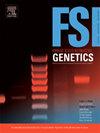Cost-effective optimisation and validation of the VISAGE enhanced tool assay on the Illumina NovaSeq 6000 platform
IF 3.1
2区 医学
Q2 GENETICS & HEREDITY
引用次数: 0
Abstract
Numerous forensic age prediction models based on DNA methylation markers have been developed, each differing in the number of predictive markers, statistical method, biomatrix, and sequencing platform used. This variability highlighted the need for more uniformity in the development of epigenetic clocks. To partially address this need, the VISAGE Consortium introduced the VISAGE enhanced tool assay, a multi-tissue assay that targets eight age-associated genes (ELOVL2, EDARADD, ASPA, FHL2, MIR29B2CHG, KLF14, TRIM59, and PDE4C). So far, three models were built using this assay for age prediction in blood, buccal cells, and bones, based on Illumina MiSeq sequencing data with the v3 reagent kit (2 × 300 bp). Unfortunately, the existing models are neither publicly accessible nor permitted for use in forensic casework. To address this limitation, we developed our own age estimation model utilising the VISAGE enhanced tool assay in combination with the Illumina NovaSeq 6000 platform and the v1.5 reagent kit (2 × 150 bp). By employing the same assay, we streamlined the workflow and enhanced uniformity, as there was no need to identify additional age-associated genes. By adjusting the assay’s primer concentrations, we achieved sufficient read depths to accurately determine methylation levels, even for longer amplicons with partial sequencing strand coverage. This modified assay was used to develop an age estimation model in blood (n = 98) with a mean absolute error (MAE) of 3.22 years and root mean squared error (RMSE) of 3.77 years in the test set (n = 30). Overall, this study demonstrated that by adjusting primer concentrations, equal age estimation performances can be achieved with the added benefit of drastically reduced costs and turn-around-time by using a 2 × 150 bp sequencing strategy. Additionally, this study was the first to independently validate the VISAGE enhanced tool assay on a different sequencing platform, exploring its potential for broader applications and partially answering the need for more uniformity.
在Illumina NovaSeq 6000平台上对VISAGE增强工具进行了经济高效的优化和验证
已经开发了许多基于DNA甲基化标记的法医年龄预测模型,每种模型在预测标记的数量、统计方法、生物基质和使用的测序平台上都有所不同。这种可变性强调了表观遗传时钟的发展需要更加均匀。为了部分解决这一需求,VISAGE联盟推出了VISAGE增强工具检测,这是一种针对8个年龄相关基因(ELOVL2、EDARADD、ASPA、FHL2、MIR29B2CHG、KLF14、TRIM59和PDE4C)的多组织检测。到目前为止,基于Illumina MiSeq测序数据和v3试剂盒(2 × 300 bp),使用该方法建立了三个模型,用于血液、口腔细胞和骨骼的年龄预测。不幸的是,现有的模型既不能公开访问,也不能用于法医案件工作。为了解决这一限制,我们利用VISAGE增强工具检测结合Illumina NovaSeq 6000平台和v1.5试剂盒(2 × 150 bp)开发了自己的年龄估计模型。通过采用相同的检测方法,我们简化了工作流程并增强了一致性,因为不需要识别额外的年龄相关基因。通过调整分析的引物浓度,我们获得了足够的读取深度,以准确地确定甲基化水平,即使是部分测序链覆盖的较长扩增子。该改进方法用于建立血液年龄估计模型(n = 98),测试集(n = 30)的平均绝对误差(MAE)为3.22岁,均方根误差(RMSE)为3.77岁。总体而言,本研究表明,通过调整引物浓度,使用2 × 150 bp测序策略,可以实现相同的年龄估计性能,并大大降低成本和周转时间。此外,该研究首次在不同的测序平台上独立验证了VISAGE增强工具分析,探索了其更广泛应用的潜力,并在一定程度上满足了对更均匀性的需求。
本文章由计算机程序翻译,如有差异,请以英文原文为准。
求助全文
约1分钟内获得全文
求助全文
来源期刊
CiteScore
7.50
自引率
32.30%
发文量
132
审稿时长
11.3 weeks
期刊介绍:
Forensic Science International: Genetics is the premier journal in the field of Forensic Genetics. This branch of Forensic Science can be defined as the application of genetics to human and non-human material (in the sense of a science with the purpose of studying inherited characteristics for the analysis of inter- and intra-specific variations in populations) for the resolution of legal conflicts.
The scope of the journal includes:
Forensic applications of human polymorphism.
Testing of paternity and other family relationships, immigration cases, typing of biological stains and tissues from criminal casework, identification of human remains by DNA testing methodologies.
Description of human polymorphisms of forensic interest, with special interest in DNA polymorphisms.
Autosomal DNA polymorphisms, mini- and microsatellites (or short tandem repeats, STRs), single nucleotide polymorphisms (SNPs), X and Y chromosome polymorphisms, mtDNA polymorphisms, and any other type of DNA variation with potential forensic applications.
Non-human DNA polymorphisms for crime scene investigation.
Population genetics of human polymorphisms of forensic interest.
Population data, especially from DNA polymorphisms of interest for the solution of forensic problems.
DNA typing methodologies and strategies.
Biostatistical methods in forensic genetics.
Evaluation of DNA evidence in forensic problems (such as paternity or immigration cases, criminal casework, identification), classical and new statistical approaches.
Standards in forensic genetics.
Recommendations of regulatory bodies concerning methods, markers, interpretation or strategies or proposals for procedural or technical standards.
Quality control.
Quality control and quality assurance strategies, proficiency testing for DNA typing methodologies.
Criminal DNA databases.
Technical, legal and statistical issues.
General ethical and legal issues related to forensic genetics.

 求助内容:
求助内容: 应助结果提醒方式:
应助结果提醒方式:


